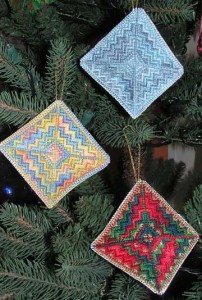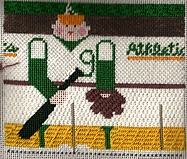
Updated June 9, 2020
Depending on what you want to change on the canvas, there are different ways to go about this.
There are some general rules to remember when changing colors:
1. If you are changing from one color to another (i.e. green to red for example) you will have the best results if you keep the colors the same in value.
2. If you are changing values (i.e. going from blonde to dark brown hair), you should color the canvas to something closer to the shade BEFORE you start to stitch. This will make any needlepoint dandruff blend into the stitching instead of sticking out.
3. Check the new colors you have chosen to be sure they work with the remaining colors by lining the colors up together. Sometimes changing one color means you will have to adjust or change other colors as well.

Skin & hair – If you are changing these areas, you should just be able to change them without changing other areas. But you might want to color the canvas first. The Reggie canvas, above, will have the skin color changed to a medium brown. No other changes need to be made.
Geometrics – Since these don’t refer to anything in real life, you may find that changing one color affects the other colors. So if you changed green to red, you may find that you also need to change the yellow-green and the pink already in the piece in order to keep the overall piece in balance. You can see in the picture at the top of the article, the same geometric ornament in three colors.
Not getting a balanced color scheme is probably the biggest problem when changing colors. If it is something realistic, look at real life objects the new color and make appropriate changes. For example, if you are stitching roses and change your red roses to yellow ones, you might need to change the leaf color. Many of my red roses have dark true green leaves, but my yellow ones have mid-range slightly yellowed green leaves.
In geometric or abstract designs, you need to be aware of the color scheme of the original and start by using that as the basis for your change. If the original is red and green and you change the red to violet, you probably need to change the green to yellow as well.
If you change the saturation of the colors (brightness) you must keep the value the same. If you go from greyed to bright, look for bright shades of the same color in the same value.
In geometrics, it’s critical to check the threads.
And always, when changing colors, you should be willing to make adjustments as you stitch.
About Janet M Perry
Janet Perry is the Internet's leading authority on needlepoint. She designs, teaches and writes, getting raves from her fans for her innovative techniques, extensive knowledge and generous teaching style. A leading writer of stitch guides, she blogs here and lives on an island in the northeast corner of the SF Bay with her family

Leave a Reply